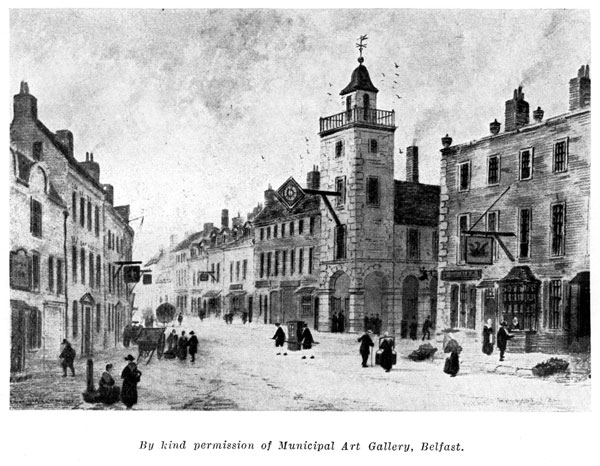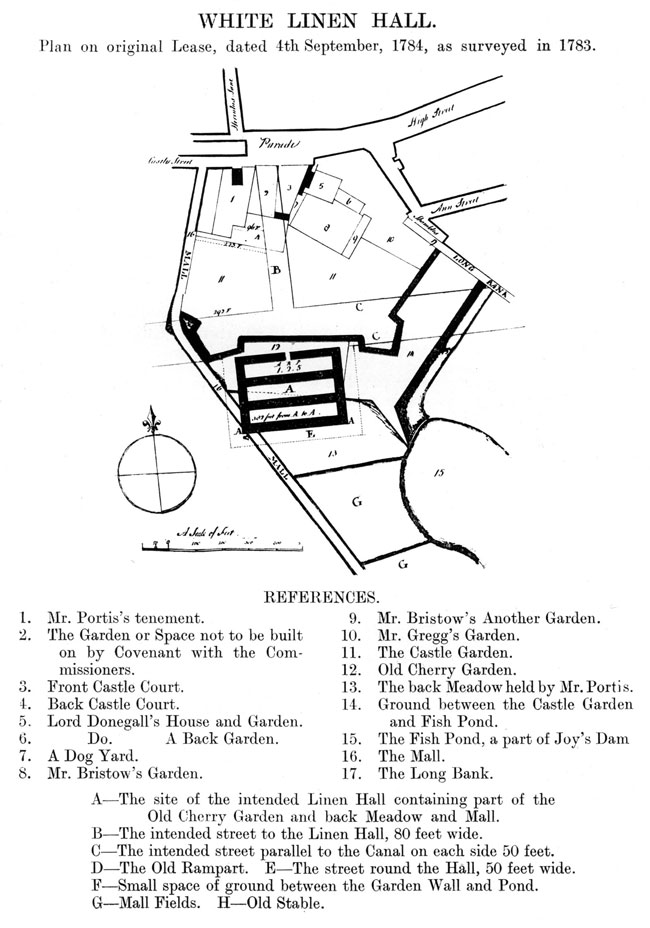THE MARKET HOUSE

The water-colour by Thomas Wakeman, 1780, in the McGowan Collection, of which the above is a reproduction, is one of the most interesting historical pictures in the Belfast Art Gallery. Apart from the definite delineation of the Market-house, it shows the character of the "New Buildings", erected shortly after the destruction by fire of the Castle and which afterwards became noted as "Paddy Gaw's Corner." On the north side of Castle Street there is shown a portion of the Donegall Arms alias The New Inn, before it was pulled down in 1786 to be enlarged and rebuilt by James Sheridan, as the following advertisement in the Belfast News-Letter shows :-
| JAMES SHERIDAN |
| Takes this Method of acquainting his Friends and the Public that he has (for some months until the Donegall Arms Inn can be rebuilt) removed from thence to Ann Street, generally called the Back of the Green, to the House formerly the Office of Thomas Greg, Esq., which is fitted up elegantly, and is well calculated in all respects for carrying on his business in its usual extensive manner. |
| Belfast, May 9, 1786. |
The principal feature of the picture is the carefully executed delineation of the Market House which, for over a century, was the hub of the town's activities. After the Restoration, the Burgesses threw an increased energy into the management of the borough and they soon realised, in the words of the Corporate Records --
"there hath been a longe time past great want of a Court House or Town Hall for this Corporacon of Bellfast whereby the decency of this Borrough hath recvd prejudice and detrimt both in ye body Corporate & Pollitique."
The Sovereign, Geo. McCartney, was the lessee of the Market House and, with the consent of the Earl of Donegall, rented the "upper parte of these Sellers next ye Market place", when it was agreed that "ye sume of five pounds per annum be paid to ye Sovraigne for ye said Court House soe longe as it shall be for ye Townes use". In addition to the rent of £5 per annum he was to receive the sum of £20 16s. 9d. as he
"hath upon his own Charge made a paire of Stayres to ye said House and adorned it with his Majties Armes and caused Seats both necessary and convenient for ye afforesd use of ye sd Corporacon." ... "ye Roofe of ye sd Court House to be repaired at ye charge of ye said now Soveraigne."
Such was the first, Town Hall and Court House of Belfast wherein the municipal affairs were to be managed and also where Justice was to be administered to such delinquents as were brought before the Sovereign as Chief Magistrate.
The Sovereign, according to the Charter of 27th April, 1613, was Judge of a Borough Court of Record and was also constituted a "Justice and Keeper of the Peace". He presided at a Court of Petty Sessions, commonly called "The Sovereign's Court", which was held bi-weekly and, at which Court, some resident or neighbouring Justices usually attended.
The "Sellers", or ground floor of the building, had iron gates and were similar to the openings of the Exchange which was built by the 5th Earl of Donegall to commemorate the birth of his son and heir, George Augustus, in August, 1769.
The houses on the near side of the Market House are deserving of particular attention, as they hore the distinctive name of Paddy Gaw's Corner. They occupied the site of the original Gatehouse of the Castle which was leased to the Rev. Dr. Tisdall, and afterwards, 14th June, 1717, leased to R Lebyrtt and described in the parcels --
"all that and those tenements south of Castle Street commonly called the New Buildings, being nine small houses together with the yard behind the said houses called the Butcher's Shambles."
By deed, bearing date 22 April, 1780, Henry Ellis of Prospect, Carrirkfergus. conveyed to Patrick Gaw, tobacconist
"AIl that piece or parcel of ground situate on the south side of Castle Street... containing in width at the front next the said street 47 feet and extending backwards 105 feet as also that other piece of ground lying in Cornmarket Street containing in front 35 feet... and extending backwards about 44 feet with the buildings over the Gateway and also the stable lying at a little distance from the said piece of ground..."
Patrick Gaw seems to have been a celebrity of his day and apparently a man of considerable means. His name appears as a "new member" of the First Presbyterian Meeting-house in 1783. and frequently it occurs on old legal documents as a witness to signatures. He seems to have died about 1792, as, on 1st November, 1792, his property was conveyed by "the heirs-at-law of Patrick Gaw of Belfast, merchant deceased" and the name of those heirs-at-law, as given on the deed, are:
Margery McCrone otherwise Gaw widow:
Elizabeth Connor otherwise Gaw widow
Thomas Milliken & Susanna Milliken otherwise Gaw his wife;
Henry Haslett & Jane Haslett otherwise Gaw his wife:
John Boyle & Anne Boyle otherwise Gaw his wife,


